Tuesday, August 5, 2025. Annette’s Roundup for Democracy.
The Smithsonian surrenders to Trump and then changes its mind.
Joyce Vance - The Washington Post reported on Thursday that “The Smithsonian’s National Museum of American History in July removed references to President Donald Trump’s two impeachments from an exhibit display. A person familiar with the exhibit plans, who was not authorized to discuss them publicly, said the change came about as part of a content review that the Smithsonian agreed to undertake following pressure from the White House to remove an art museum director.”
Rewriting history is Orwellian to the core. Breathtakingly, shockingly so. The fact remains that even though the Senate refused to convict on either occasion, Donald Trump was impeached twice, the only president that has happened to during a single term in office. The first time was for attempting to use much-needed security aid that Congress had voted to send to Ukraine as a quid pro quo to obtain an announcement from that country’s brand-new leader at the time, Volodymyr Zelenskyy, that Joe Biden was under investigation in that country for corruption. The second impeachment was in connection with January 6.
That is the history of our nation, which nothing can change.
But in the novel, facts are not a barrier. Rewriting history is a central tenet of the totalitarian regime, carried out by the Ministry of Truth.
Smithsonian will again include Trump in impeachment exhibit in 'coming weeks.’
The museum's decision to remove a placard referring to President Donald Trump from an impeachment exhibit sparked concerns over Trump's influence on the cultural institution.
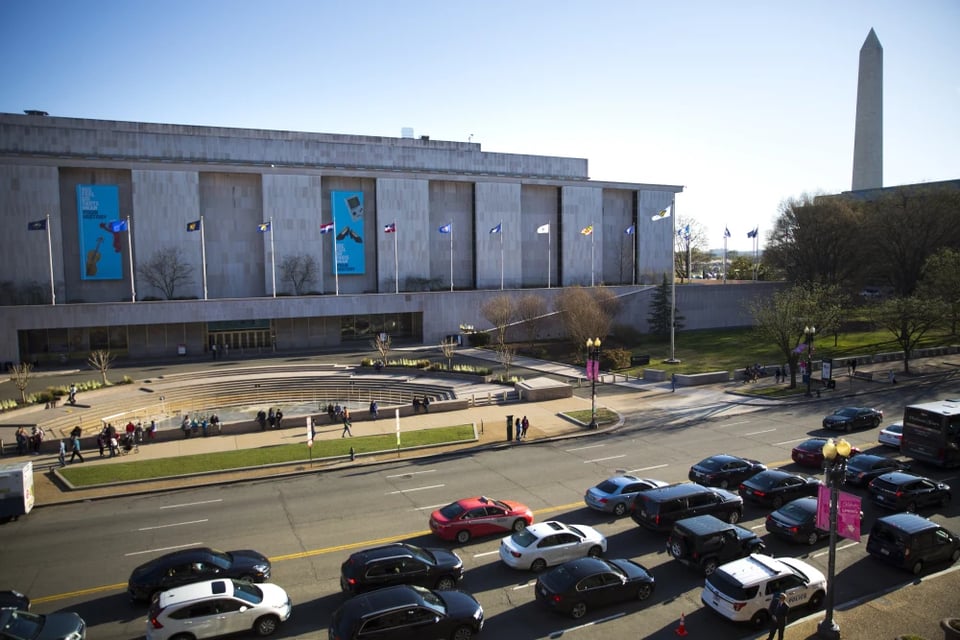
The Smithsonian's National Museum of American History will once again mention President Donald Trump in an exhibit on presidential impeachments after the removal of a placard noting his two Senate trials sparked concerns this week over the White House's influence on the institution.
In a statement on Saturday, the Smithsonian detailed its decision to remove the Trump placard from the "Impeachment" section of an exhibit titled "The American Presidency: A Glorious Burden," saying the decision was not influenced by politics, but rather the conditions of the placard.
"The placard, which was meant to be a temporary addition to a 25-year-old exhibition, did not meet the museum’s standards in appearance, location, timeline, and overall presentation," the Smithsonian's Saturday statement read. "It was not consistent with other sections in the exhibit and moreover blocked the view of the objects inside its case. For these reasons, we removed the placard."
The "Impeachment" section of the exhibit "will be updated in the coming weeks to reflect all impeachment proceedings in our nation’s history," the Smithsonian said.
The Washington Post was the first to report on the changes to the exhibit.
According to the Post, the Trump references were removed from the exhibit after the Smithsonian undertook a content review following pressure from the White House and accusations of partisan bias.
In its statement, the Smithsonian said it was "not asked by any Administration or other government official to remove content from the exhibit."
“The American Presidency: A Glorious Burden” exhibit was created in 2000 and hasn’t been formally updated since 2008, a spokesperson for the Smithsonian told NBC News on Thursday. In lieu of an update, which the museum indicated would be costly, the Smithsonian in 2021 affixed a placard noting Trump's two impeachments to the exhibit.
“It was intended to be a short-term measure to address current events at the time, however, the label remained in place until July 2025," the spokesperson said Thursday.
Because the exhibit, which also covers Congress and the Supreme Court, hadn’t been updated since 2008, the museum decided to restore the “Impeachment” section of the gallery “back to its 2008 appearance," the spokesperson said at the time.
The decision to remove the Trump label drew criticism from lawmakers, particularly as Trump has sought to exert his influence over the Smithsonian, which encompasses 21 museums, nine research centers and a zoo.
Senate Minority Leader Chuck Schumer, D-N.Y., on Friday accused Trump of attempting to "rewrite history."
"He is censoring the American History Museum. It’s Orwellian. It’s downright Orwellian. It’s something you’d see in an authoritarian regime," Schumer said. "Here’s my message to the president: no matter what exhibits you try to distort, the American people will never forget that you were impeached not once, but twice."
Trump has called for a reimagining of the Smithsonian, accusing the cultural institution in March of coming “under the influence of a divisive, race-centered ideology” and signing an executive order to “restore the Smithsonian Institution to its rightful place as a symbol of inspiration and American greatness.” In that order, Trump directed Vice President JD Vance to work with the Smithsonian's Board of Regents to "remove improper ideology" from the museums.
Trump also barred spending on exhibits or programs "that degrade shared American values, divide Americans based on race or promote programs or ideologies inconsistent with Federal law and policy."
Last week, artist Amy Sherald said she withdrew her exhibit from the Smithsonian's National Portrait Gallery after concerns were raised about a portrait she featured of a transgender woman dressed like the Statue of Liberty.
"I was informed by the National Portrait Gallery that concerns had been raised internally about the museum’s inclusion of a portrait of a trans woman titled Trans Forming Liberty. These concerns led to discussions about removing the work from the exhibition," Sherald said in a statement. "I cannot in good conscience comply with a culture of censorship, especially when it targets vulnerable communities."
A spokesperson for the Smithsonian disputed Sherald's characterization of the incident, arguing that the artist was not asked to remove the painting, but rather the museum wanted to contextualize the portrait through a video featuring differing opinions of it.
"The Smithsonian strives to foster a greater and shared understanding. By presenting and contextualizing art, the Smithsonian aims to inspire, challenge and impact audiences in meaningful and thoughtful ways. Unfortunately, we could not come to an agreement with the artist," the spokesperson said. (NBC News)
The Smithsonian Board.
Chancellor (Chief Justice) | John G. Roberts Jr. |
Ex‑officio Vice Chair (Vice President) | J.D. Vance |
Senate Regents (3) | John Boozman; Catherine Cortez Masto; Gary Peters |
| House Regents (3) | Carlos A. Giménez; Adrian Smith; one other rep |
| Citizen Regents (9) |David M. Rubenstein (Chair) | Co‑founder and co‑chair of the Carlyle Group; philanthropist especially noted for historic preservation giving to the Smithsonian, National Archives, and museums; former citizen regent and past chair of the Board of Regents. |
| Steve M. Case (Vice Chair) | Former CEO of AOL and investor/entrepreneur; serves as vice chair among citizen regents. |
| Barbara M. Barrett | Businesswoman, attorney, diplomat; served as U.S. Secretary of the Air Force (2019–2021) |
| John Fahey | Business and civic leader |
| Roger W. Ferguson Jr. | Former Vice Chair of the Federal Reserve |
| Michael Govan | Director of the Los Angeles County Museum of Art (LACMA) |
| Risa J. Lavizzo‑Mourey | Public health leader and nonprofit executive; chair of the Board’s citizen regents executive committee. |
| Michael M. Lynton | Former film and media executive (Sony Pictures, Snap Inc.) |
| John W. McCarter Jr. | Longtime nonprofit and civic leader |
One more thing.
In firing the economist who keeps the Government labor data honest, Trump drew feed-back.
Here is the headline from the digital New York Times.
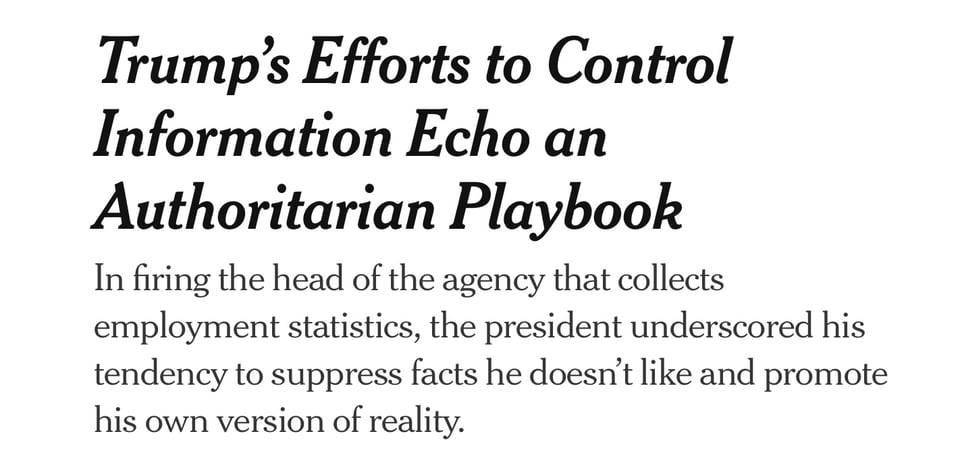
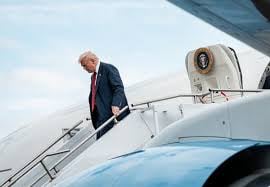
Trump’s behavior around the Economy also makes clear that he knows nothing about economics. Oh our poor country!
Our President Is Economically Illiterate

When my kids were in college, I insisted that they each take at least one economics course. Being economically illiterate ranks, in my mind, just below not being able to read or write.
Now we have a president who is fundamentally ignorant of the most basic and incontrovertible economic principles, as evidenced in his latest round of foolhardy tariffs (and in so many other ways).
President Trump has been told over and over again by economists of all political persuasions that tariffs are much like a sales tax and will ultimately be paid by American consumers; he likely would have been taught that concept during his time at the University of Pennsylvania’s Wharton School.
And while the overall inflation rate has only been edging up since Mr. Trump began imposing tariffs, the cost of many imported items has been escalating. In June, prices for furnishings and durable household equipment — a category with high import exposure — rose by 1.3 percent, the biggest increase in more than three years. Prices for recreational goods and vehicles, which are also frequently manufactured abroad, increased by 0.9 percent, the largest jump since February 2024.
And tariffs likely played a role in the sudden slowdown in payroll growth announced on Friday, with the economy having created just 106,000 jobs in the last three months, far less than its monthly average in recent years.
Mr. Trump’s response? Shoot the messenger: He directed his team to fire the head of the Bureau of Labor Statistics, which compiles the figures.
Mr. Trump’s ignorance goes far beyond the tariffs-are-a-tax concept. He believes trade deficits are tantamount to “losing” money to other countries. Losing money is what happens when $100 falls out of your wallet. When you spend $100 to buy new earbuds made in China, you haven’t lost it; you’ve spent it on earbuds.
(Unsurprisingly, Mr. Trump also regularly misstates the size of the trade deficit. It’s not the $2 trillion he claims; last year it was under $1 trillion.)
Moreover, the tariffs that Mr. Trump is imposing reflect no rhyme or reason. What is the point of imposing a 40 percent tariff on poor Laos? The country is hardly in a position to buy much from us.
Mr. Trump’s fervent belief in tariffs seems to have originated in the 1980s, as Japanese cars flooded into the United States and wreaked havoc on domestic car manufacturers. Yet those same carmakers — such as Ford and General Motors — have been among the most vociferous opponents of his tariff regime today. Their latest financial results suggest that they stand to lose somewhere between $1 billion and $4 billion in earnings this year from Mr. Trump’s tariffs.
Mr. Trump has demonstrated his economic ignorance in many other ways — with potentially even greater adverse consequences. His most recent, and potentially most dangerous, transgression has been his harsh and wrongheaded criticism of the policies of the Federal Reserve and its chairman, Jerome Powell.
Mr. Trump insists that our interest rates are too high and should be as low as Europe’s (2 percent versus our 4.5 percent). Yet when he pronounces our economy “the strongest in the world,” as he regularly does, he is unconsciously citing one of the reasons for our higher interest rates: Robust economies need higher interest rates to restrain inflation.
Indeed, Mr. Trump seems not to understand inflation. He repeatedly — sometimes on multiple occasions in a single week — pronounces that we have “no inflation.” In fact, in the most recent 12 months, prices rose by 2.6 percent over the prior year, still modestly above the Fed’s 2 percent target and perhaps accelerating.
Another reason for our elevated interest rates is the massive budget deficits that we have been running, deficits that Mr. Trump made worse with the tax cuts he pursued in his first term and continues to push in his second. His signature domestic policy law will increase the deficit — and therefore our borrowing needs — by an estimated $3.4 trillion over the next decade.
Mr. Powell’s term is coming to an end next year, and the prospect of Mr. Trump picking his successor is downright scary. In his first term, Mr. Trump tried to appoint several individuals to the Federal Reserve Board who were so manifestly unqualified — with views that were so wildly outside of any accepted principles of monetary policy — that many Republicans refused to support them and they were forced to withdraw.
Mr. Trump now clearly regrets his decision to appoint Mr. Powell in 2017. A more unbridled Trump 2.0 might try for a far less responsible candidate whose selection to the most important and powerful economic position in our government could easily upend financial markets and perhaps the entire economy.
The president barely seems to comprehend supply and demand, which are among the most basic concepts in economics. He evangelizes for lower oil prices but simultaneously calls on the energy industry to “drill, baby, drill.” Lower prices discourage drilling; the number of rigs in operation has been falling as oil prices have softened.
In a similar vein, while he acknowledged that tariffs would raise the prices of imported cars, he argued that Americans could avoid tariffs by buying cars made in America. But it is well documented that when the price of an imported item goes up, domestic producers are then free to increase their own prices — and often will.
To be fair, the president occasionally shows glimmers of economic comprehension. With regard to the dollar, for example, he understands that the mantra of many Treasury secretaries that “a strong dollar is in the national interest” is more complicated than that simple sentence suggests. While a strong dollar has many advantages, a weak dollar makes our exports more competitive and restrains imports by making them more expensive (admittedly potentially creating inflationary pressures).
“I know better than anybody what’s good for the Market, and what’s good for the U.S.A.,” Mr. Trump proclaimed in a recent social media post. “People don’t explain to me, I explain to them!” Perhaps he should consider flipping those two clauses. (Steve Rattner, a counselor to the Treasury secretary in the Obama administration, Op-Ed, The New York Times).
The Rose Garden will soon look like a parking lot, but this 👇 is even worse.
Trump’s White House Ballroom Is a Crude Solution
Trump’s White House Ballroom Is a Neoclassical Bludgeon An overscale, reactionary solution to the question of where to host a big state dinner.
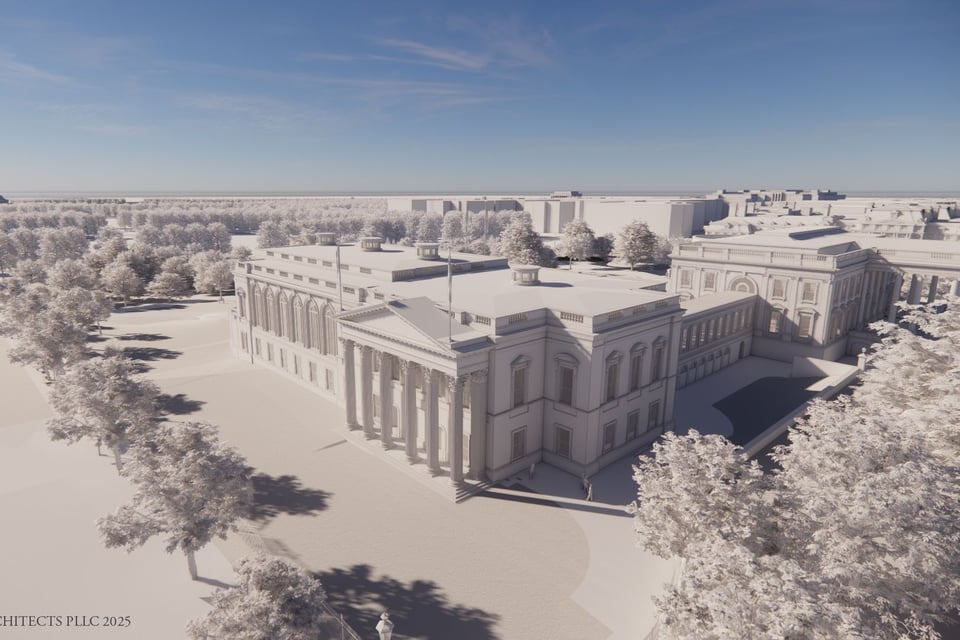
Long before he was president, Donald Trump was griping about the tent. “I see that the White House … when a dignitary comes in from India, from anywhere, they open up a tent,” he said in a 2011 interview. “A tent! … An old, rotten tent that frankly, they probably rented.” He’s been talking about replacing it with a permanent ballroom for a long time, in his usual Dictator Chic idiom. As usual, we all thought he was too distractible and inept to get it done. In his first term, he was, and now he isn’t. Karoline Leavitt showed everyone the plans today.
Let’s set aside for a moment the symbolism of this project. Viewed that way, it’s monstrous. That Trump will build a ballroom — the most on-the-nose embodiment of let-them-eat-cake Versailles extravagance — just as he throws old people off Medicare and kids off food stamps is as big a trolling as has ever been trolled. And you just know it’s going to become the Donald J. Trump Ballroom, whether he puts that name on it or someone applies it in order to suck up to him. We’re going to have to look at that name on announcements of public events for a very long time. At least this latest portion of the White House, unlike the original, won’t be built by enslaved people. Probably.
Considered strictly from the viewpoint of the building arts, it could be worse. The plans indicate a large structure replacing much of the East Wing, budgeted at $200 million. In the renderings, at least, it is highly contextual — that is, its detailing closely mimics the detailing of the building as we know it. It too will be white, Federal with French influences, and approximately neoclassical.
The portico appears to be a shallower version of the original by James Hoban — the one with the triangular pediment on the house’s north side, not the rounded one on the south. If we’re going by these preliminary renderings — which, granted, are often flattering — the massing and exteriors are pretty innocuous. The only thing that’s not clear is the scale of the thing and whether it will compete visually with the rest of the house.
On that subject, Trump’s urge to make everything bigger than it ought to be is a foreboding sign. He could also demand that a floor or five be added tomorrow, or for that matter order that a statue of himself be placed on the roof; who’d stop him? He’s a marble-columns guy.
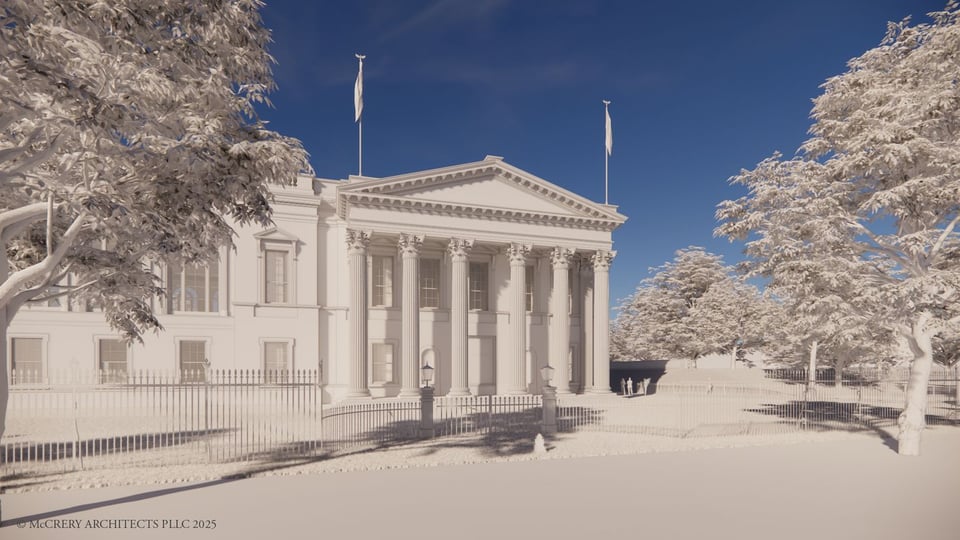
The east front of the proposed new wing.
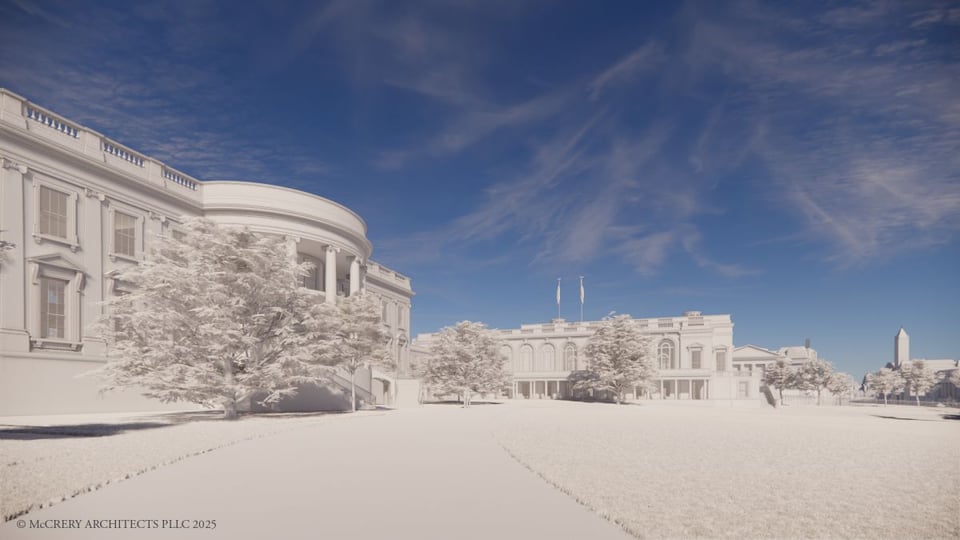
A view across the South Lawn.
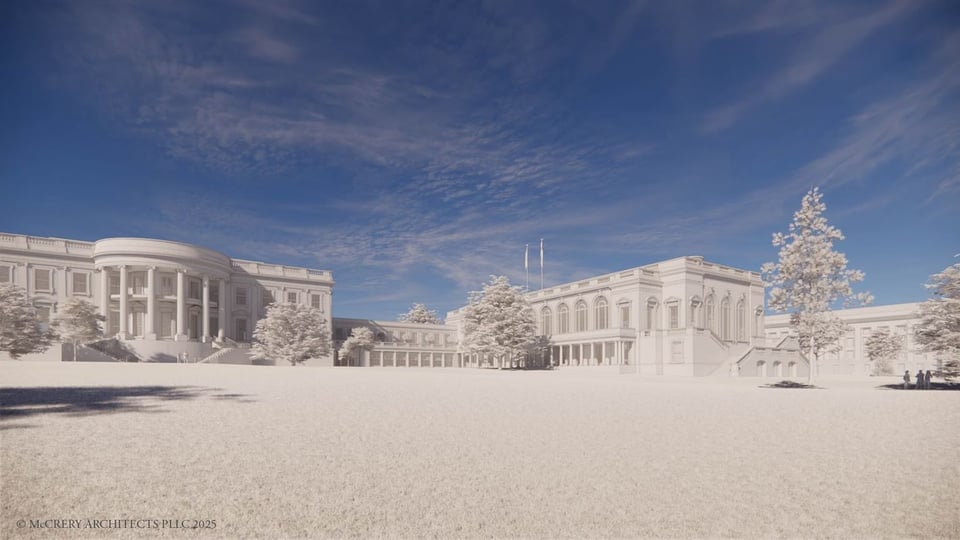
Seen from the south.
Yet again, Trump has found something that irritates him and gone at it — as is his custom — with a chain saw and a staple gun where the tools should be a good deal more surgical. The problem is a known one: The White House is, indeed, an old and awkward headquarters from which to run a country. The house itself — that is, the central structure whose outer stone walls date to 1800, not the East and West Wings — is inarguably large, at 55,000 square feet.
Nowadays, though, a 20-something internet magnate can swing a suburban Dallas spread that size. A dinner in the East Room, the largest in the building, maxes out at 200 seats, barely larger than your cousin’s wedding. The new structure will measure 90,000 square feet and seat 650 at once.
It’s worth recalling that the White House has changed a lot over the years. Until the 1960s, the house was redecorated at will by each First Family, much as they would a private home, and that is still largely true of the residential quarters upstairs. One massive rehab, in the early 1880s under Chester Alan Arthur, added bulbous Gilded Age gaslight chandeliers that dominated the state rooms. A photo from 1889 shows the East Room with a huge gasolier and a staggering array of patterns on every surface. The Louis Comfort Tiffany stained-glass screen Arthur commissioned for the ground floor’s Cross Hall was a beautiful object, and it was also howlingly inappropriate in an 18th-century interior, as incongruous as an Eames lounge chair would look in the Red Room.
In the next few decades, the interiors got much less on-trend. After World War II, the building was rebuilt from the inside out — literally; it was falling apart — and furnished with department-store ersatz antiques.
Only when Jackie Kennedy arrived did it become a museum of American decorative arts, its curation handed off to the nonprofit White House Historical Association. Even so, and despite that status, its look continually evolves, inside and out. The Kennedy-era Blue Room is quite different from subsequent versions. Out back, Barack Obama repurposed the tennis court for basketball. Melania Trump, back when she lived under the same roof as her husband, built a pavilion next to it.
As for the wings, East and West, they were tacked on in the early 20th century by Theodore Roosevelt, and the current Oval Office dates only to the 1930s. (FDR’s Art Deco eagle medallion on the ceiling, rarely seen, is the tip-off.) It is, in other words, a house with an ongoing life.
And those ancillary areas, if we’re being honest about it, have been worked hard and show it. People who visit the West Wing often remark on its cramped and underwhelming offices. Every bit of space that can be squeezed out of it has been. The rather elegant pool house built there by FDR, for example, was planked over during the Nixon administration in order to build the current, somewhat frumpy Press Room. (The tiled pool is still down there beneath Kaitlan Collins and Peter Baker, and it holds broadcasting equipment and cables.) The West Wing really is too small for today’s executive branch — not that a party room will help any of that.
The Trump ballroom will be a much more intrusive addition to the grounds than any of those structures were, but even this big blocky project has some architectural precedent. Take a look at the plans laid out around 1890 by Caroline Harrison, the wife of Benjamin Harrison. She thought the house was much too small to meet its needs, which it probably already was, and proposed two immense ells on either side, plus a vast greenhouse across the lawn.
The drawings show a north façade that is mostly contextual (Federal-repro porticoes) and a south front that is less so (topped with Victorian domes of vaguely mansard form). For reasons of budget, and probably aesthetics too, it wasn’t built. Instead, Mrs. Harrison settled for greenhouses on the lawn and yet another interior renovation.
In one sense, Trump is doing here what he’s done with everything else: take a hatchet to all that we think is settled and instead declare the 19th century (golden ballrooms for the rich, unregulated coal-mining and factory jobs for everyone else, a measles epidemic now and then) the best and most aspiration-worthy time America has ever had.
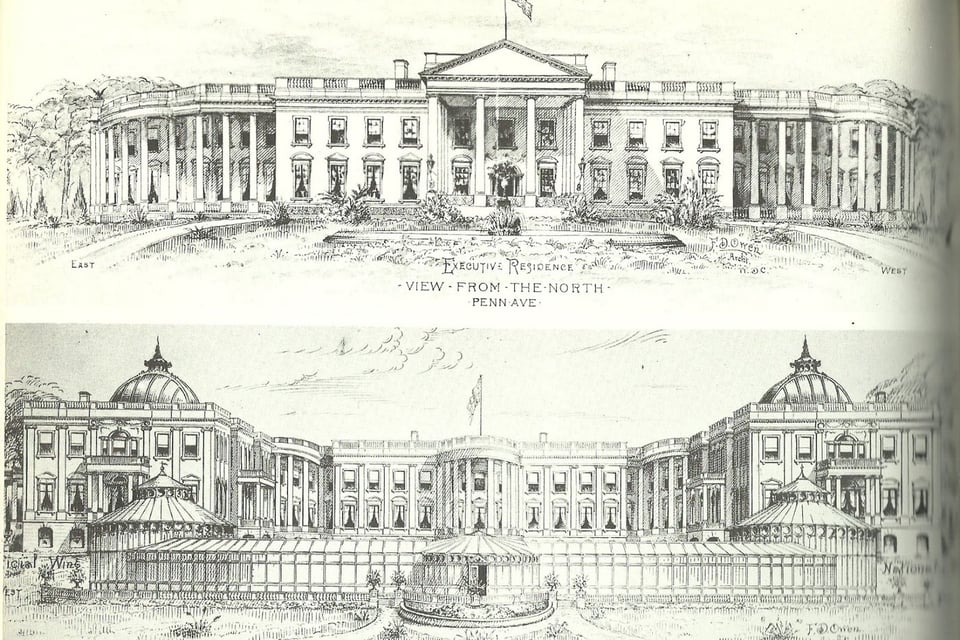
The Benjamin Harrison administration had even more grandiose expansion.
So if neither the form nor the precedent for this East Megawing is all that bad, why does this project give thinking people the willies? Well, to start with, the renderings of the interior — meant to show it at its best and brightest — look dreadful. Much as Trump has ordered a bunch of faux ormolu to be tacked up around the Oval Office while chucking out some genuinely dignified touches, he’s clearly going to gild this thing up like Saddam Hussein’s Kalashnikov, and the result will be dismayingly familiar.
The current East Room may be golden already, but the difference is in the details, and if the recent past is any guide, it’s going to be the world’s starchiest casino.
Second is the price: $200 million is a lot of money, but when you’re building for the leader of the free world, it doesn’t go nearly so far as you’d think. Everything costs extra, whether it’s for bulletproof windows or walls full of secure electronics. This is the type of extremely ordinary building a $150 million government budget buys. (No doubt Trump’s supporters will say he’s a private developer and knows how to get more for less, but the White House can’t just skip out on its bills.)
There will also likely be cost overruns, much as there have been in the Fed’s multibillion-dollar renovation, and he will blame someone for those, most likely firing that person in a humiliating manner. The old White House is built of limestone; at this price, he’s likely to clad the new wing in something much less timeless. The golden doodads in the Oval Office look cheap, and perhaps they are. I would not be surprised to see a Dryvit Executive Mansion Ballroom next.
Then there’s the source of that budget. Trump says he and his rich friends will cover the costs for the new wing. That means the cronies will be on the hook, because it’s well-known that Trump rarely pays for anything if he can get someone else to do it. It’s one more eye-popping opportunity for wealthy people to buy access to this presidency, and you can’t realistically imagine that they won’t take it.
All of that said, I’ll offer one other thought that (maybe) mitigates the grossness of this project.
The White House, as I’ve said above, goes through architectural cycles. Those gaudy, ridiculous 19th-century renovations lasted about 20 years, after which Theodore Roosevelt tore them out in favor of the restrained work of McKim, Mead & White, which laid the visual foundation for the rooms’ appearance today. The Eisenhowers’ tacky furniture gave way to the Kennedy renovation.
The renderings of the Trump Ballroom’s décor are cheesy as hell — but eventually, the ballroom, like the rest of the house, will change. Someday, long after this administration has ended, the thing it built will just be part of the building. President Ocasio-Cortez’s First Gentleman, or a comparable figure, will order its schlockier elements pared off and replace them with something more restrained and subtle.
It is, unlike the human toll inflicted by this administration, just a new building, and whatever is wrong about it can — slowly, painstakingly — be undone.
(Curbed, New York magazine).
The Anti-Democratic Texas Fiasco.
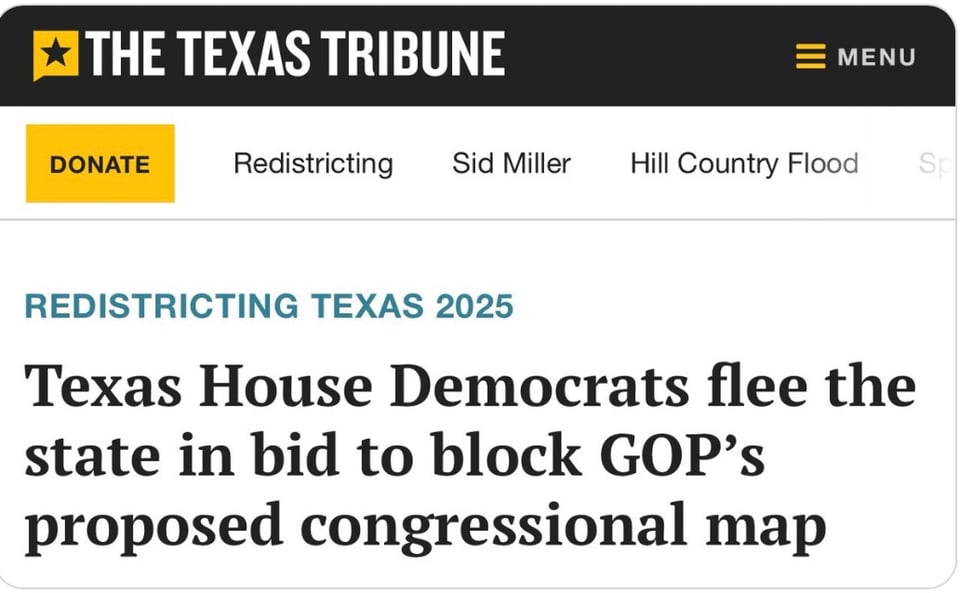
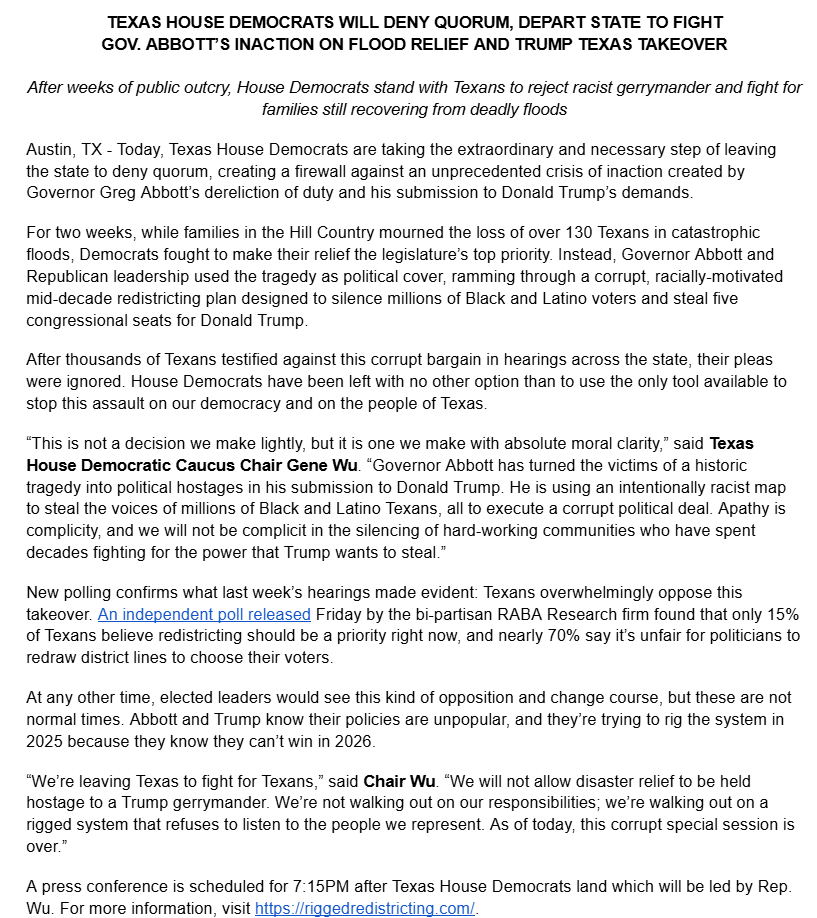

Republican leaders in the Texas House fast-tracked the redistricting legislation before introducing any bills responding to the deadly floods in the Texas Hill Country — putting Democrats in the position of potentially walking out on legislation that addresses needs caused by the flooding.
Keep this in mind too.… [In 2021] the Texas House adopted rules that call for fines of $500 per day for any member who is absent without approval, a measure adopted after Democratic members broke quorum during a 2021 legislative fight over voting and redistricting. (Source. NY Times)
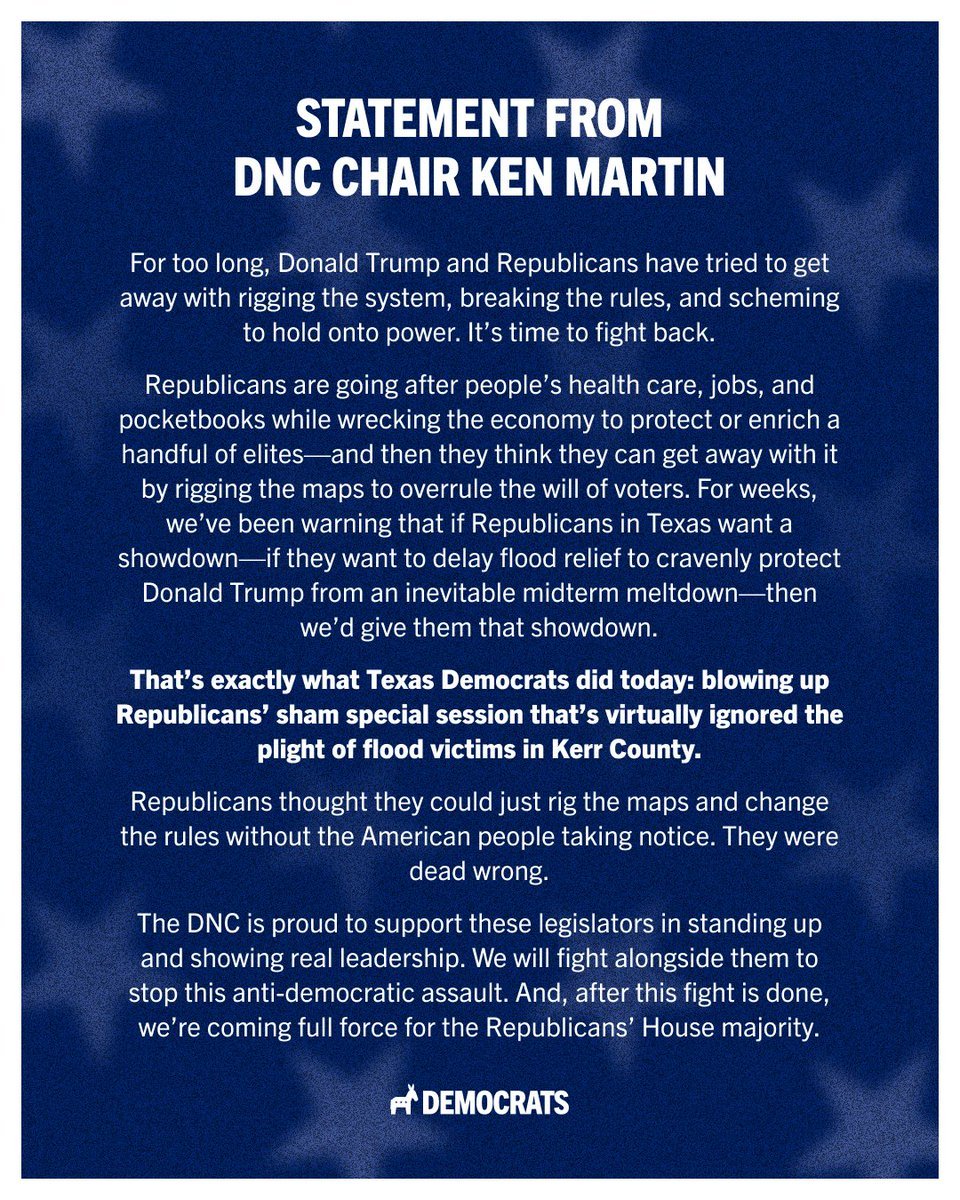
“Courage is contagious.”
— Jennifer Get In Good Trouble (@TheJenniWren) August 4, 2025
And Governor JB Pritzker just proved it.
While Texas Republicans try to rig maps and silence voters, Texas Democrats are putting everything on the line to protect democracy—and now, they’ve got backup.
Pritzker isn’t just cheering from the sidelines.… pic.twitter.com/5FHFsExhcW
🚨MASSIVE: JB Pritzker just stood with the Democrats who fled Texas to block Abbott’s power grab:
— CALL TO ACTIVISM (@CalltoActivism) August 4, 2025
“(Texas Republicans) are attempting to cheat... I think we all know Trump is a cheater. So is the Attorney General of Texas, Ken Paxton.”
This is what fighting back looks like. pic.twitter.com/FRcwvBS7fb
“Other Democratic governors have also been considering moves to redraw their maps, including Gov. Phil Murphy of New Jersey and Gov. Kathy Hochul of New York [and Gov. Gavin Newsom of California].” (Source. NY Times).
I am thinking about Virginia everyday! You should too.
All eyes are on Virginia — and Election Day is 3 months from today!
— Abigail Spanberger (@SpanbergerForVA) August 4, 2025
I’m not taking a single vote for granted. Let’s work together and make sure we set an example for the rest of the country on November 4. pic.twitter.com/sm4NSFBK8p